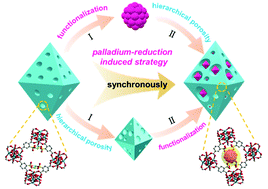Construction of a functionalized hierarchical pore metal–organic framework via a palladium-reduction induced strategy†
Abstract
Hierarchical porosity and functionalization are recognized as two crucial parameters in mediating the catalytic performance of heterogeneous catalysts, however, they are rarely achieved simultaneously in the development of metal–organic frameworks (MOFs). In this work, a simple and efficient method has been developed to synchronously construct hierarchical porosity and functionalization within a sulfonic acid group functionalized microporous MOF via a palladium-reduction induced strategy, for the first time. The generation mechanism of the mesopore has been explained using two-dimensional 1H DQ-SQ MAS NMR. The content of the mesopore and the active sites within mesoPd@NUS-6 could be finely tuned by simply controlling Pd loading. Particularly, the combination of hierarchical porosity and functionalization, as well as the ultra-stable structure endow the composites with great potential in bulk, for adsorption and heterogeneous catalysis.



 Please wait while we load your content...
Please wait while we load your content...